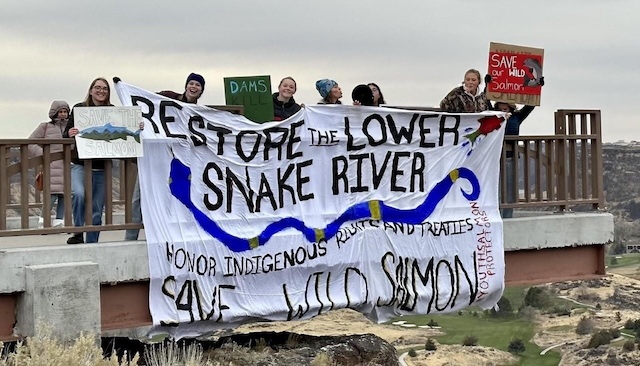forum
library
tutorial
contact

Students Demonstrate in Twin Falls
for Action on Salmon Recovery
by Tony Tekaroniake Evans
Idaho Mountain Express, November 23, 2022
|
the film forum library tutorial contact |

|
Students Demonstrate in Twin Falls
by Tony Tekaroniake Evans
|
Youth Salmon Protectors call for dam removal on lower Snake River
 A group of high school students from the Wood River Valley dropped a banner from the Perrine Bridge in Twin Falls on Nov. 12 that read "Restore the Lower Snake River" and "Honor Indigenous Rights and Treaties."
A group of high school students from the Wood River Valley dropped a banner from the Perrine Bridge in Twin Falls on Nov. 12 that read "Restore the Lower Snake River" and "Honor Indigenous Rights and Treaties."
Their public demonstration, which also occurred elsewhere along the rim of the Snake River Canyon, was meant to draw attention to an effort to breach the four lower Snake River Dams in Washington and restore wild salmon and steelhead runs.
Endangered sockeye salmon migrate more than 900 miles from spawning areas in the Sawtooth Valley near Sun Valley to the Pacific Ocean, and back, the longest run in the Lower 48 states. Dams on the Lower Snake River are an impediment to their journey.
"This isn't just about fish and breaching the dams," said 17-year-old Wood River High School senior Lilia Page. "It's about rural communities that face Endangered Species Act regulatory issues. We've done a lot of recovery work in the Upper Salmon basin, but that work isn't recovering fish fast enough."
Page and fellow Wood River senior Hazel Ludwig, 17, recently founded a Wood River Valley Chapter of Youth Salmon Protectors, a coalition of student-led salmon advocates in the Pacific Northwest supported by the Idaho Conservation League, a nonprofit conservation organization.
"We started a chapter in the Wood River Valley because we wanted to broaden our perspective of climate activism from local projects to regional differences," Page said. "This issue affects the whole Pacific Northwest and impacts many people and habitats."
Page said part of the salmon recovery issue involves tribal fishing and hunting rights and that the Youth Salmon Protectors join the Nez Perce and Shoshone-Bannock tribes of Idaho in urging the federal government to honor treaties that ensure salmon as a traditional food source.
"Some activists in the Northeast see this aspect as a human rights issue," Page said. "But we don't focus on this aspect because we have no tribal members in our group and don't want to represent them."
Page said after starting the group, the students were "overwhelmed" by the many facets of issues surrounding salmon, from the need for power generation and shipping of grain, to the regulations surrounding endangered species.
"It's very complex, and we are still learning a lot," Page said. "There are so many aspects to understand and yet salmon could go extinct in 20 to 30 years if we do nothing."
The Salmon Youth Protectors met last summer with other activists at 100-foot-tall hydropower-producing Ice Harbor Dam in Southeastern Washington. There they formed a flotilla of kayakers to call for its removal.
"What shocked us was the scope and size of the dam, but we toured it and got to see another side of the issue, about barging [on dam-created reservoirs] and creating electrical power," Page said.
The Wood River Valley activists have also met with Youth Salmon Protectors on the Washington Coast who are working on the dam removal and Columbia Basin recovery issue in relation to orcas, large sea mammals that rely on salmon for food.
The vast river ecosystem that ties together orcas, salmon and many other species as well, reaches from the Pacific Ocean all the way to Big Creek Ranch in the Pahsimeroi Valley near Challis, which is owned by Page's father, Tom Page, and his brother, Mike Page. The brothers have taken steps to protect riparian areas from cattle grazing to help restore habitat for ocean-going salmon and steelhead.
"We don't have very many fish in the upper Salmon River Basin even though we have done restoration work on private lands and associated public lands," Lilia Page said. "This strongly suggests that there needs to be more action towards salmon recovery downstream before we can hope to improve the situation where we are. The river needs to be healthy for the rest of the ecosystem to be healthy. We need salmon, a keystone species, to return in historical numbers, but they are not doing this because of the dams."
Page said she and her cohort of activists continue to learn about the issue of salmon recovery with the help of mentors at the Idaho Conservation League. She said one part of her work with the group is to monitor federal legislation that could lead to a breaching of the dams.
"Until federal legislation is passed, we likely won't meet our deadline of 20 to 30 years, when salmon could go extinct," she said.
learn more on topics covered in the film
see the video
read the script
learn the songs
discussion forum
